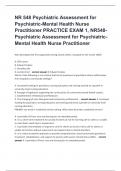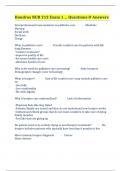NR 548 Psychiatric Assessment for
Psychiatric-Mental Health Nurse
Practitioner PRACTICE EXAM 1, NR548-
Psychiatric Assessment for Psychiatric-
Mental Health Nurse Practitioner
Who developed the first organized training school within a hospital for the insane 1882?
A. Effie Jones
B. Edward Cowles
C. Dorothea Dix
D. Loretta Ford - correct answer B. Edward Cowles
Which of the following is not a factor that led to treatment of psychiatric illness shifted away
from hospital to community settings?
A. Increased funding for psychiatric nursing education and training and led to a growth in
university-level nursing education.
B. Passage of legislation supporting the construction of community mental health centers.
C. Establishment of Medicaid and Medicare.
D. The changing of rules that governed involuntary confinement. - correct answer A. Increased
funding for psychiatric nursing education and training and led to a growth in university-level
nursing education.
PMHNPs can work in residential service setting. Which best describes residential service?
A. It provides 24-hour care and housing for an extended period.
B. It is a short-term treatment for acutely ill clients at risk for harming self or others or unable
to meet basic needs due to impairment.
C. It provides intermediate or long-term care for clients at chronic risk to self or others or
unable to function without supervision and support due to mental disorders.
D. It is a team treatment approach to provide comprehensive, community-based psychiatric
treatment, rehabilitation, and support to persons with severe mental illness (SMI). - correct
answer A. It provides 24-hour care and housing for an extended period.
,PMHNPs can work in a partial hospitalization setting. Which best describes partial
hospitalization?
A. It provides short-term treatment for acutely ill clients at risk for harming self or others or
unable to meet basic needs due to impairment.
B. It focuses on psychiatric and substance-related emergencies
C. It provides care in non-hospital community settings such as mental health clinics, homes,
worksites, shelters, crisis centers, senior centers, group homes, or schools.
D. It provides acute symptom management, intensive treatment, and safe housing for clients
who do not require 24-hour medical management or nursing care. - correct answer D. It
provides acute symptom management, intensive treatment, and safe housing for clients who
do not require 24-hour medical management or nursing care.
PMHNPs can work in psychiatric emergency services. Which best describes psychiatric
emergency services?
A. It provide acute symptom management, intensive treatment, and safe housing for clients
who do not require 24-hour medical management.
B. It occurs in the inpatient setting providing care for acutely ill clients at risk for harming self or
others or unable to meet basic needs due to impairment.
C. It focuses on psychiatric and substance-related emergencies.
D. It provides comprehensive, community-based psychiatric treatment, rehabilitation, and it
provides individualized service 24 hours a day, 7 days a week. - correct answer C. It focuses on
psychiatric and substance-related emergencies.
"The PMHNP assists other mental health clinicians to evaluate their practice, expand their skills,
and meet standards for ongoing peer supervision" describes which of the following PMHNP
roles?
A. Clinical Supervision
B. Case management
C. Psychiatric Consultation-Liaison Nursing
D. Administration, Education, and Research Practice - correct answer A. Clinical Supervision
"PMHNPs provide direct comprehensive mental health services in solo or group private practice
settings or through contracts with other entities" describes which of the following PMHNP
roles?
A. Primary care
B. Self-Employment
C. Psychotherapy
, D. Case management - correct answer B. Self-Employment
PMHNPs can in the role of Psychiatric Consultation-Liaison Nursing. Which of the following best
describes the Psychiatric Consultation-Liaison Nursing role?
A. Prescribes or recommends pharmacologic agents and may order and interpret diagnostic and
lab tests to assess treatment response or monitor for adverse effects.
B. Work in collaboration or consultation with a primary care provider or independently provide
behavioral health care in an integrated setting.
C. Involves the assessment, diagnosis, and treatment of behavioral, cognitive, developmental,
emotional, and spiritual responses of individuals, families, and significant others with co-
occurring physical illness and/or dysfunction.
D. Serves as administrators, educators, and researchers. - correct answer C. Involves the
assessment, diagnosis, and treatment of behavioral, cognitive, developmental, emotional, and
spiritual responses of individuals, families, and significant others with co-occurring physical
illness and/or dysfunction.
Which of the following PMH APRN speciality areas are correctly paired with their definition?
A. Integrative Programs- Involves the intersection of psychiatric nursing and the criminal justice
system.
B. Forensic Mental Health- Involves providing care and treatment for clients with mental
disorders, including substance use disorders and co-occurring medical disorders.
C. Disaster psychiatric mental health nursing- Involves the coordination of care and related
decision-making about mental health care for a client, family, group, or population.
D. Telehealth- Utilizes telecommunication technology to deliver care and treatment. - correct
answer D. Telehealth- Utilizes telecommunication technology to deliver care and treatment.
The Consensus Model for APRN Regulation has provided recommendations for L.A.C.E
pertaining to all APRN practice. What does the acronym L.A.C.E. stand for?
A. Licensure and Association of Clinical speciality and Education
B. Licensure Accreditation Certification and Examination
C. Licensure Advanced placement Competency and Education
D. Licensure Accreditation Certification, and Education - correct answer D. Licensure
Accreditation Certification, and Education
How does mental health diagnoses affect the average life expectancy?
A. Those with psychiatric and mental health conditions have a decreased life expectancy of
approximately 6-15-years.
B. There is no association with mental health diagnoses and life expectancy.





